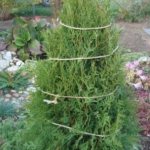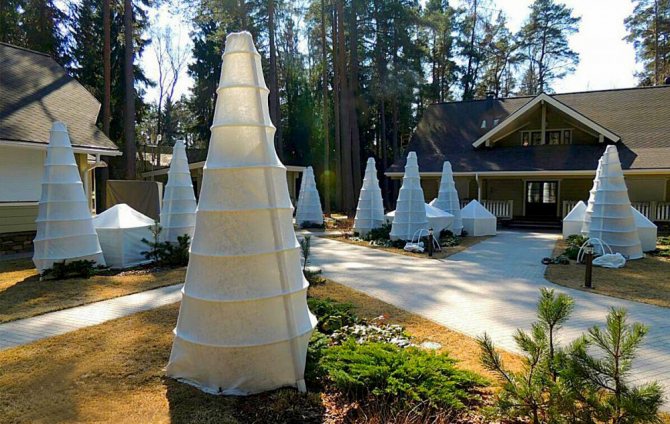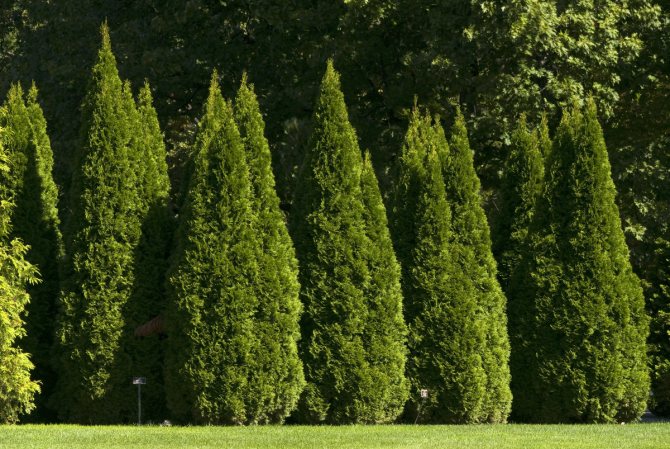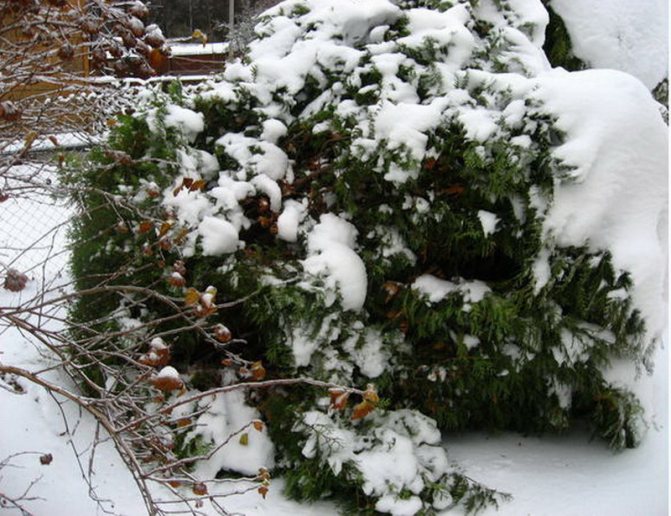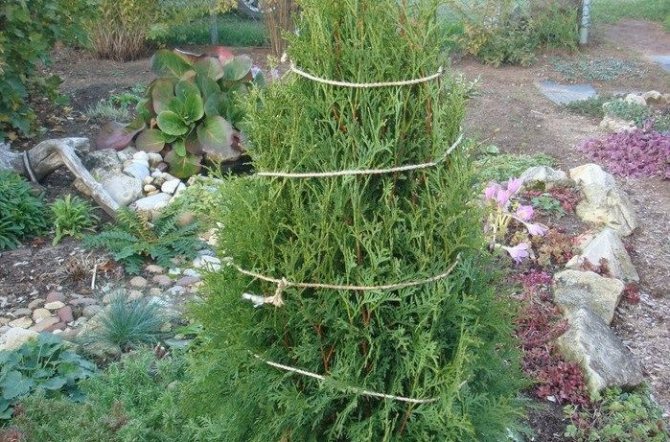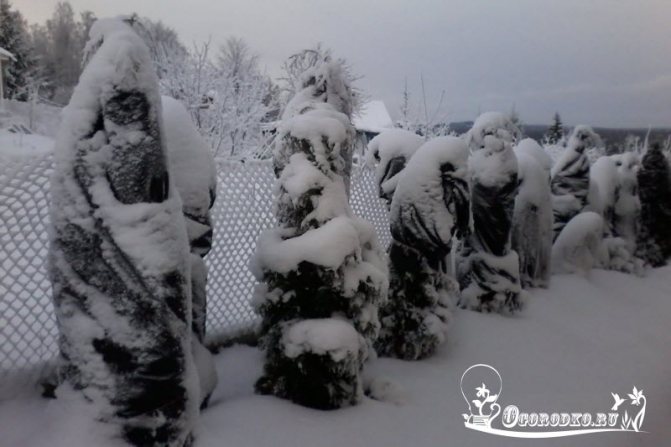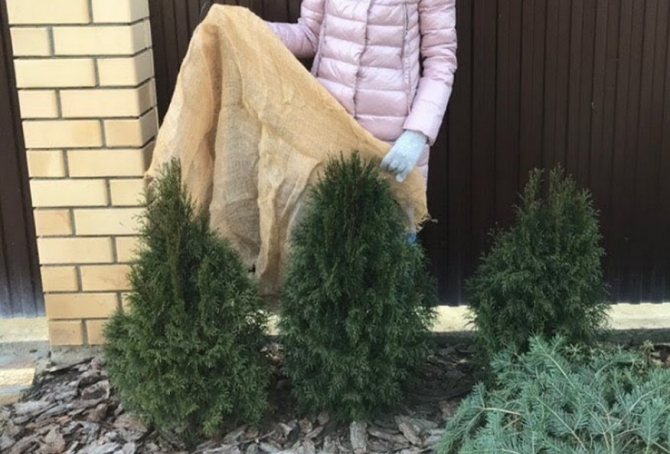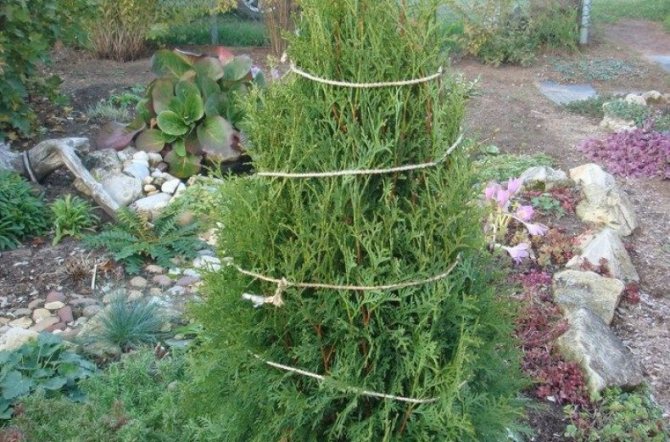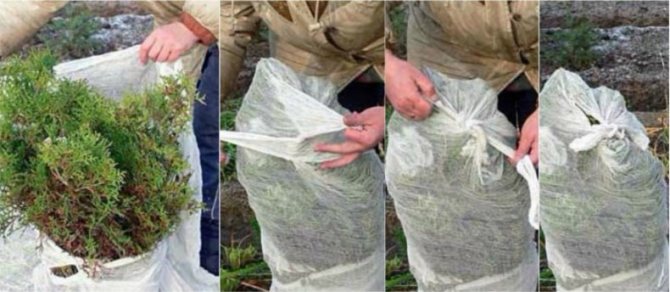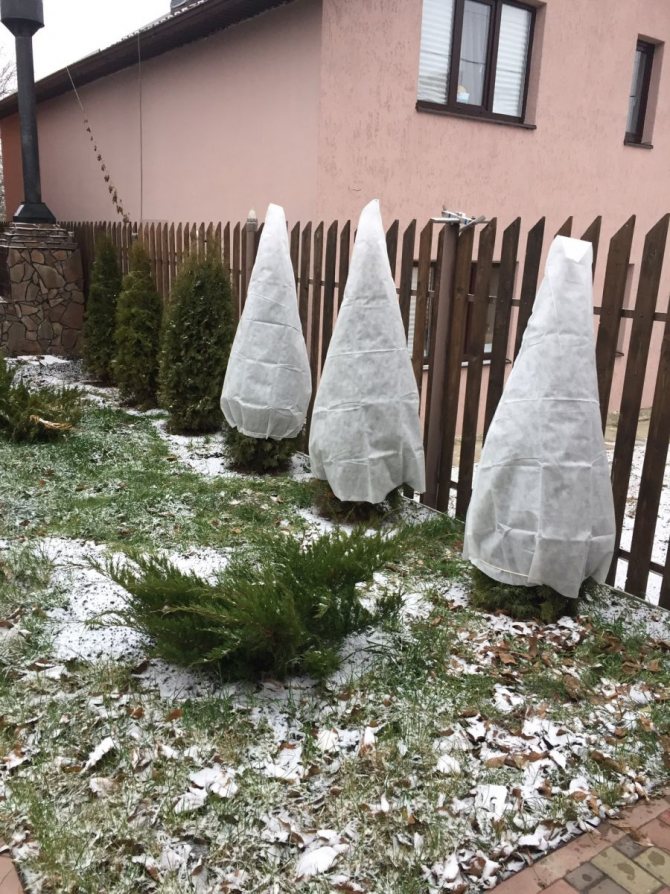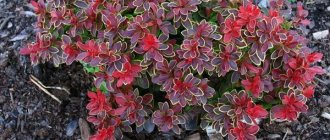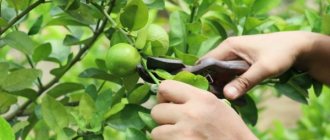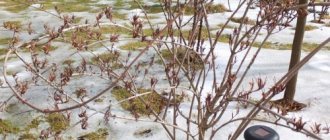Do I need to cover the thuja for the winter?

An adult plant aged 5 years and older, even at a temperature of -30 degrees, does not need shelter. The tree easily tolerates small frosts, winters well, the low temperature does not frighten it at all. For young plants, frost is a threat. The tree, which is not yet 4-5 years old, has fragile branches. When the snow covers the branches, they deform, break under the weight.
Another danger to the tree is the winter sun. It is very active, therefore, burns are often formed on the branches of thuja, the needles burn out. Even if direct sunlight does not hit the crown too much, the needles may suffer from desiccation. If the preparation of the thuja for the winter was not carried out, then it is most likely that the following disadvantages will arise on the tree:
- shoots will be twisted and ugly;
- the color of the crown will change to a yellow-green color;
- the needles will dry and then fall off.
To prevent an unpleasant outcome and preserve the culture, provide a shelter for it. Over the winter, nothing bad will happen to the thuja, but in the spring and summer it will continue to delight with an attractive view and decorate your summer cottage.
Root protection in winter
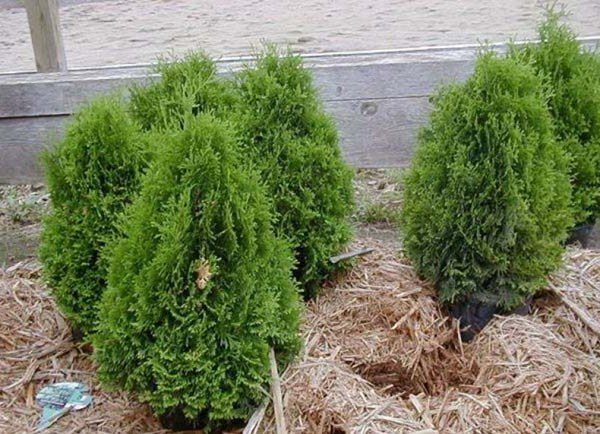

Dry frosty weather is dangerous for thuja roots. The needles evaporate a lot of moisture, which is why the roots that are close to the surface dry quickly and can freeze in frost.
Attention! Do not forget to carry out abundant water-charging watering when preparing the thuja for winter in the fall.
You will be interested to know: Indoor cypress: home care, home use, reproduction
Before frost, the following activities need to be carried out:
- Collect debris and weeds from the ground in the trunk circle.
- Loosen the soil to a depth of 5-10 cm. Do this carefully, since the root system of conifers runs close to the surface of the earth.
- Fertilizers with phosphorus and potassium were introduced into the ground.
- Sprinkle the soil with mulch in a layer of 10-30 cm. The thickness of the layer depends on how severe the frosts are in your area.
Peat, well-rotted mature manure, tree leaves from the forest, compost can be used as mulch for warming the roots of thuja, coniferous soil, straw. If severe frosts are expected, cover the mulch with additional spruce branches after frost. In the spring, when warming, it must be removed, and the mulch must be left. It is an excellent organic fertilizer.
How to cover thuja
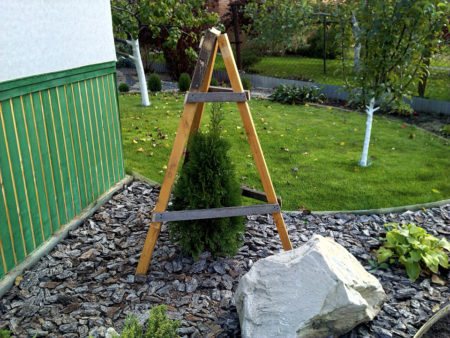

Shelter of a thuja for the winter is a simple process, but a little painstaking, since accuracy will be required. Tie the branches of the tree with a thick twine to begin with. Do not overtighten the twine, otherwise it will be difficult for the branches. It is enough to fix the crown so that the snow cannot fall on the branches. Gather the branches up towards the center of the tree, and then start tying in a circle. Start the process at the base of the tree and gradually work your way up to the top.
If heavy snow falls in your area with the onset of winter, it makes sense to build a frame. It is necessary to drive 3 pins made of metal or wood into the ground next to the crop. They should intersect at one point - above the top of the tree. Then wrap the frame with an air-permeable covering material. Be sure to reinforce the material to the frame so that it will not be blown away by the wind gust.Tie it with twine, for example.


In stores that offer a large selection of garden tools, sometimes there are special covers for plants on sale. Get them, they are easy to use and will serve you for more than a dozen years. The cover just needs to be put on and spread on the thuja, then the plant will stand wonderfully all winter, until the beginning of spring. In the spring, remove the cover, wash and dry; you will not need it until autumn.
Another way to hide is by installing a sunscreen. It can be a wooden box or a homemade device. Drive the pegs into the ground parallel to each other. Cover the space between the pegs with roofing material and a special sun-protection cloth. Such a shelter will prevent the needles from burning out even in spring, when the sun is very active.
To protect thuja in winter, use a few good tips:
- annual and biennial trees are covered first, even before the snow falls;
- if a lot of snow fell during the winter, remove it from the shelter;
- the shelter can be removed after the snow begins to melt.
It is more convenient to cover the tree with two or three people. Ask someone in your family to help you, and you will be done in just a few minutes.
Insulation of roots


In addition to keeping the crown warm and from sun protection, you need to think about how to insulate the root system. The roots of young plants are exposed to frost, and the plant itself will quickly die if the roots are frozen. Suitable for warming the root system:
- peat or any other organic component. The main condition is that the mulch must have a loose layer;
- a mixture of fallen autumn leaves with earth or humus. In addition to protection from cold weather, such a mixture will eventually become an excellent fertilizer for the root system;
- sawdust, straw.
The thickness of the mulch layer should be at least 5 cm, but not more than 10 cm. The mulch is placed near the tree trunk circle, and the lapotnik is laid on top of it. It will protect the root system from rodents and press down on the mulch.
How to choose a covering material
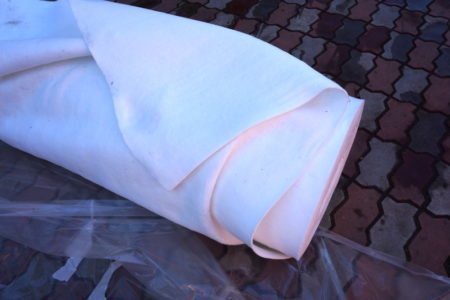

Choose the material for covering the thuja depending on its throughput, it must be high and allow air to penetrate inside. It is strictly forbidden to take material that does not allow air to pass through, for example, cellophane film. A greenhouse effect will develop under it, as a result of which the tree will begin to rot, shed the needles and become sick. The best material for a winter shelter is:
Read also Pickle for pickles for 1 liter
Choose a material with a white color, in addition to heat, it will reflect the sun's rays from the tree, thus the needles will not "burn". Therefore, if you chose a black roofing felt for shelter, wrap a white sheet or duvet cover over it.
How to keep thuja in a pot
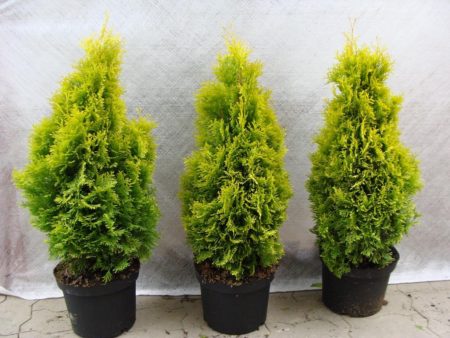

If your thuja is still small, then it is probably still sitting in a pot. Then there will be no problems with shelter, just with the onset of severe cold weather, remove the tree from the street to a cool room, put the pot with the plant in the basement, cellar, or take it out to the glazed balcony. The optimal temperature range for wintering thuja is considered to be from 4 to 10 degrees Celsius. Check that there is no high humidity in the room, and that the plant itself is well spilled and wrapped with craft paper. It is desirable that there is a light source in the room, for example, a small window. You can move the thuja to a cool room for the winter, but just keep the plant away from radiators and open the window for fresh air.
The ways
Preparation of thuja for winter begins in the fall, before the first frost and snow. The simplest option is bags of a suitable size, which are fixed with twine. An adult plant with strong roots is enough to wrap with a strong rope. Another way to hide high varieties of thuja involves the construction of a frame. It is not difficult to make it - just drive in three metal pins over the top of the thuja (crosswise) and fasten. Then cover the frame with a non-woven fabric. Special shields that create shade will perfectly protect from the spring sun. Low-growing shrubs can be covered with wooden boxes. Snow from "insulated" trees must be shaken off periodically.
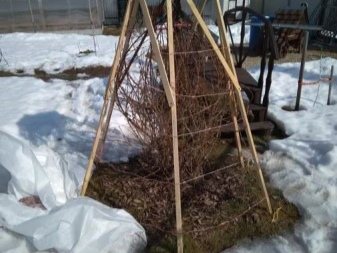

Many gardeners plant evergreen thuja in tubs. In winter, the plants are taken indoors or covered with non-woven material. As a rule, a drain is installed at the bottom of the container, which is great for keeping moisture in the pots. It is enough to water the plant and cover it with a cotton bag, securing it around the trunk with wire or rope. It is important to know that a coniferous tree cannot survive the winter in a dark and damp room. In winter, certain conditions are necessary for thujas growing in tubs.
- The optimum temperature of the content should not exceed +5 degrees. If the thermometer in the room drops to -3, then the pots are additionally insulated.
- Regular watering. In winter, the soil in tubs should not be allowed to dry out. This will lead to yellowing and shedding of the needles of the tree.
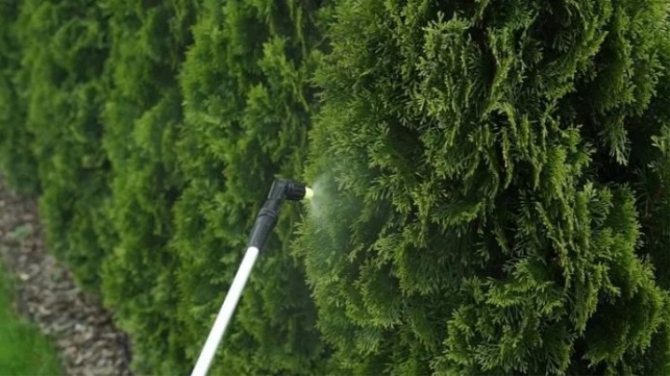

Also, thuja in containers winters well on a glazed balcony. Taking care of the plant will not be difficult. The tree will be able to receive the necessary lighting and fresh air. Before the onset of frost, the plant is abundantly watered and wrapped with kraft paper. During the winter, water is periodically poured into the bowls under the pots. The permissible room temperature should not exceed +12 degrees.
Read also: Wooden floor in the Rostov dog enclosure
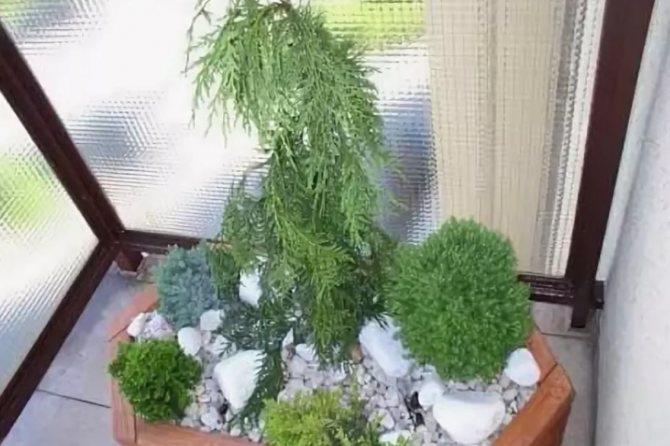

When is the best time to hide
You need to close a tree in different regions in different ways for the winter. It depends on the onset of cold weather in a particular region, on the length of winter and on its average temperature. So, in the southern strip, the tree does not have to be covered for the winter. It grows quietly both in the summer cottage and in the forest. But for other regions, in order to preserve thuja in winter, you need to make a little effort.
Middle lane
Cooling in the middle lane begins in late October or early November. At this time, when there is still no snow, a 5-centimeter layer of mulch is laid near the tree trunk circle, covered with spruce branches and the culture is left to winter. Around the second part of winter, from the end of January, sun-reflecting screens are installed next to the tree to protect the needles. There is no need to wrap the crown with agrofibre, since the temperature in the Middle Lane rarely drops below +20 degrees, and overheating is dangerous for a tree.
Volga region
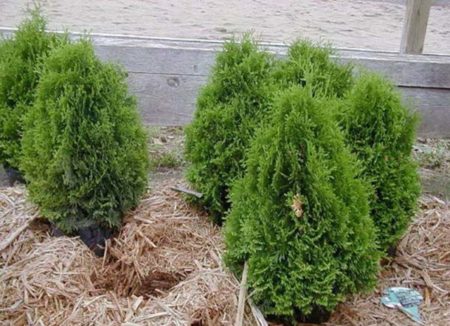

Winter comes to the Volga region at the end of autumn, so from the end of October you can start winter preparation. For the Volga region, as well as for the Middle zone, only mulch is laid for the wintering of thuja. The layer can be put thicker, its height will be about 10 cm. Only young trees can be sheltered from the cold. Take a 5 liter plastic bottle, cut off the bottom and cover the tree with it. To keep the color out of the plastic, wrap it in a white pillowcase. If your thuja is more than 4 years old, then do not wrap it up for the winter, it will stand just fine.
Ural and Siberia
In the northern part of the country, winter comes very early, literally in mid-October, so preparations begin earlier than in the central part of Russia. To begin with, the soil is mulched with a layer of peat or sawdust 10 cm thick. Spruce branches are placed on top of the mulch. Then a tapered wire frame is made. Agrofibre or any protective material is pulled over the wire, fixed on top with a twine so that it does not fly off. In addition to the wire frame, you can wrap it in spunbond. The shelter from the tree is removed in Siberia no earlier than mid-March, since the frost lasts a long time in the region.
Features of thuja care
Full care of the plant is necessary, because it depends on how well the needles will endure the winter, and how it will develop in the next season.


The list of basic manipulations included in the autumn care cycle include:
- watering, which allows you to saturate the root system with the necessary moisture;
- top dressing - carried out with compounds containing nitrogen and phosphorus (seedlings of the first year do not need additional nutrition, the root is sensitive, therefore it can suffer from many drugs);
- pruning - always carried out before wintering, the main purpose is sanitary, it is important to remove damaged needles from the crown;
- treatment from diseases and pests, carried out on demand, upon detection of noticeable signs of damage;
- mulching and the organization of a protective shelter from snow.
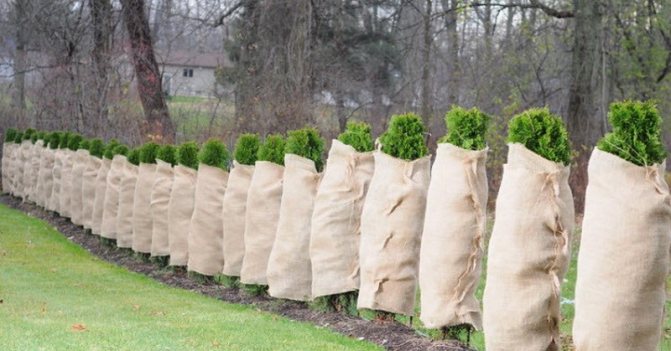

Attention! Plants of the first year of life, especially if they are planted in autumn or summer, must be covered for the winter.
Otherwise, thuja can be severely affected by frost. After a year, it is not necessary to make a defense.
Sanitary pruning
Carrying out a full-fledged pruning of thuja for the winter in the first year is a big mistake of the gardener. It is only necessary to do a sanitizing haircut, that is, to clean the young plant from old and yellow needles, cut off the overgrown branches. It is convenient to eliminate them with a sharp pruner. Dead parts, diseased and dry branches are also removed.
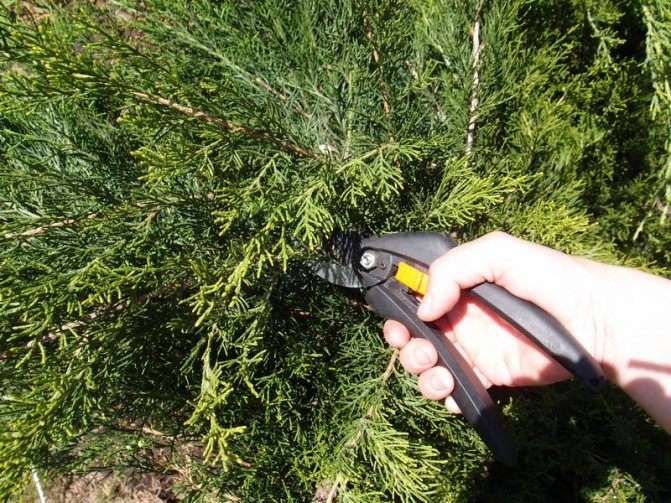

The main formative pruning is carried out in the spring and summer during the period of active growth. At the end of autumn, it is only permissible to edit the result of the work and slightly adjust the given shape, that is, cut out the branches that have started to grow in the wrong direction.
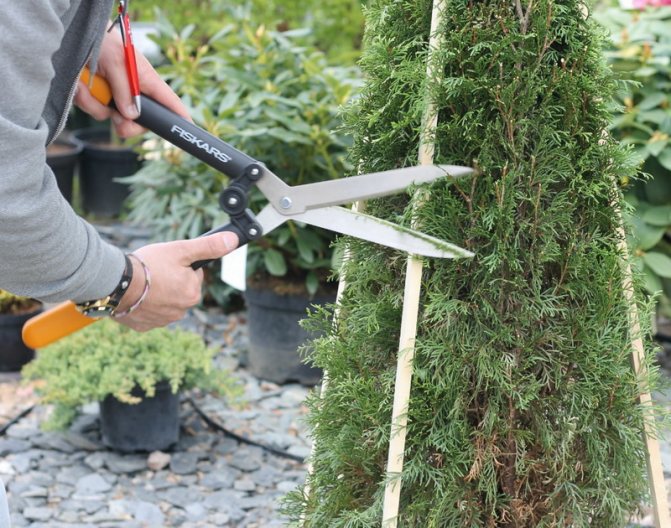

Thuja is sensitive to moisture, so pruning should be done in dry weather. If this rule is ignored, the likelihood of developing rot is high. When cutting, the branches are minimally affected, cutting off no more than a third part at a time.
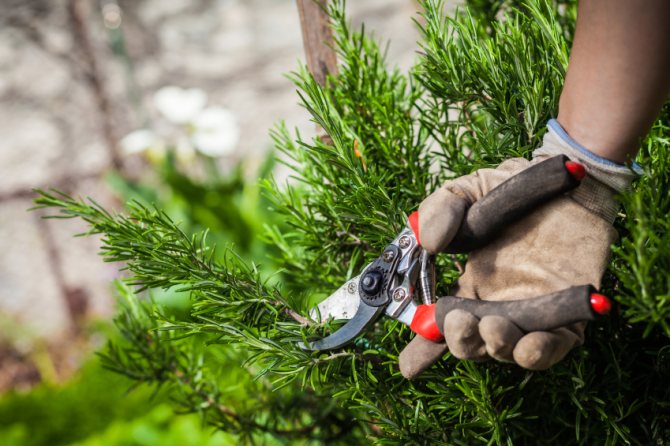

In the first year, you should not worry that the plant will overgrow and look unkempt. It should take root in a new place and start growing. Only after that you can start forming a beautiful crown.
Watering and feeding
It is not enough just to plant a plant in a summer cottage; the gardener must know how to prepare the thuja correctly for winter. During the active growing season, she needs to provide abundant and regular watering, excluding bays. Before the onset of the first frost, additional moistening is carried out on the soil - this is the technique of water-charging irrigation.
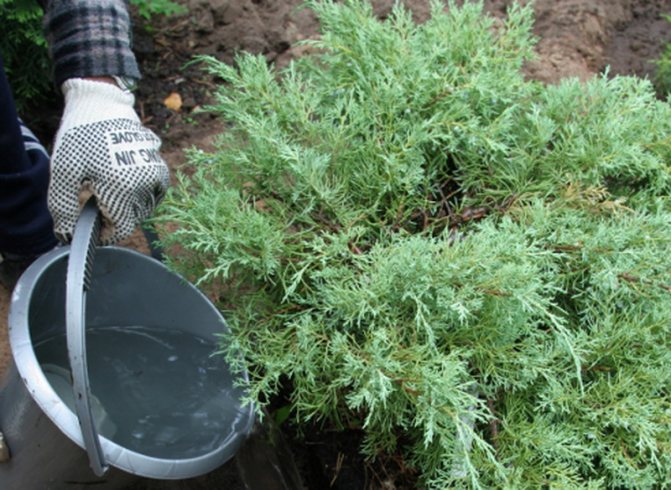

Due to the application of this technique, the root system will be saturated with water, and the earthy clod will cease to freeze. This will protect the underground part of the plant from future frosts. The culture will become resistant to significant temperature fluctuations.
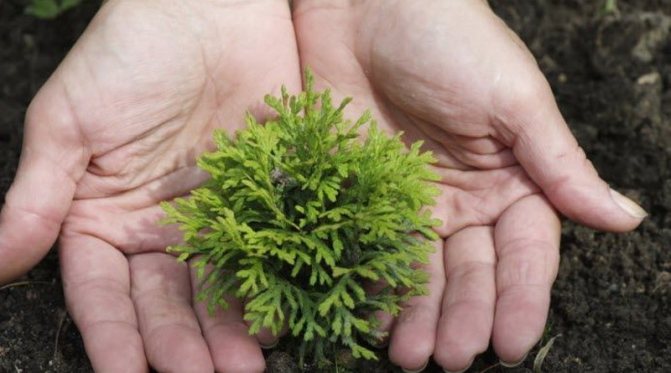

If it rained constantly in the fall and before the expected onset of the first frost, the land on the site is wet, you do not need to add additional water. Remember, the bay is fatal to all conifers, including thuja and cypress trees.


Treatment against pests and diseases
When preparing for winter in autumn, it should be treated against diseases and pests. It is worth examining the plant beforehand, because the doses for preventive and therapeutic treatment are different. If the culture is affected, after the construction of the shelter due to additional thermal insulation, the development of diseases will take place faster, until spring the thuja can die from damage.


For fungal diseases, conifers are treated with copper sulfate with Bordeaux liquid. The therapeutic dose is 30 g for 10 liters of water, and the prophylactic dose is 10 g for the same volume of liquid. It is permissible to use narrow-profile fungicides, having previously studied the instructions. Full care for thuja in the fall is not only about pest prevention. The plant, after exiting the state of sleep, needs additional nutrition, so the bush can be "refueled" with nitrogen-phosphorus compounds. This will accelerate development after an increase in daylight hours.
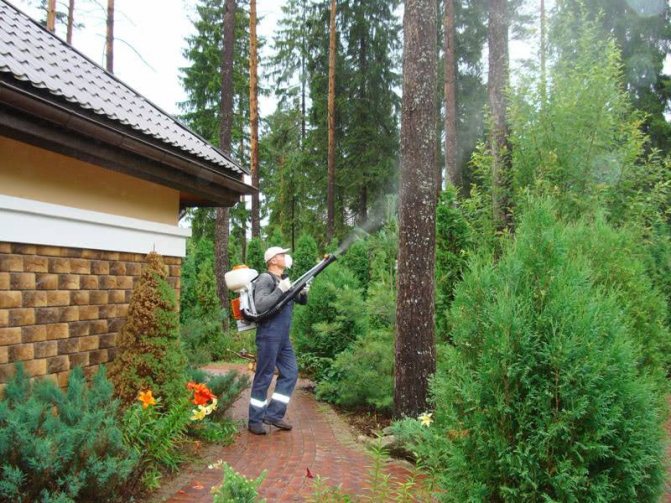

From pests, the crop is treated with specific insecticides:
- Actellik;
- Fufanon;
- Karbofos;
- Confidor;
- Topaz;
- Aktara.
The listed funds are used in the doses described by the instructions. Processing is carried out in dry, calm weather with the use of special protective equipment.
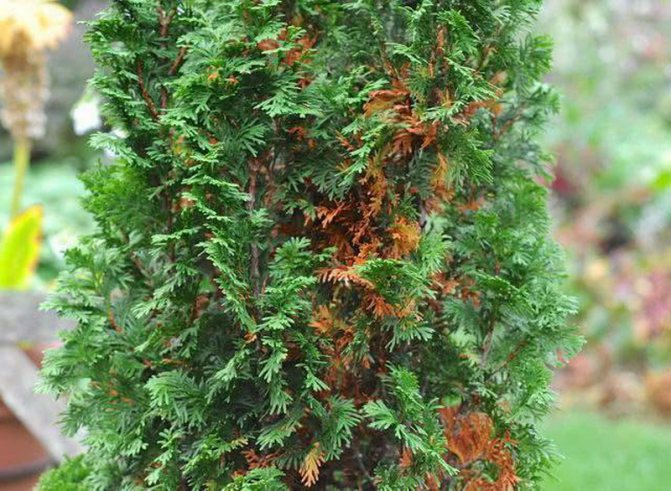

Attention! In the first year after planting, the thuja can turn yellow in the fall - this is a natural phenomenon, as an evergreen plant prepares for winter.
Root system stimulation
Not all plants need to carry out this manipulation, but only planted young growth or plants of the second year. The manipulation will ensure the fastest growth of the underground part. It is carried out before water-charging irrigation.
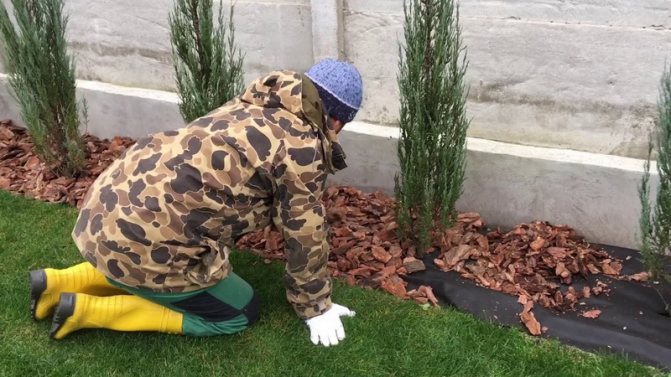

Coniferous shrubs are treated with a solution that stimulates root growth. Any root former can be used: Epin, Zircon, Kornevin. Preparations are diluted according to the instructions. After 7-10 days, a full watering of the young shrub is carried out in the near-stem circle.


Mulching
Mulch for coniferous plants should be loose, capable of passing moisture and air, the root system should not rot under it.
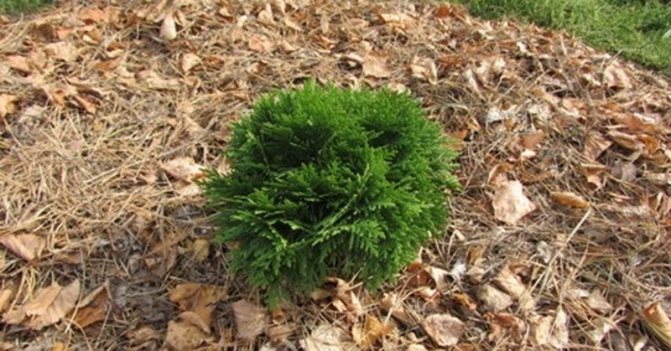

You can use:
- high-moor peat;
- straw;
- sawdust;
- bark of trees mixed with needles;
- cones;
- leaves mixed with soil.
To prevent freezing of thuja at the base, the trunk circle is mulched, laying the material in a layer of 10-15 cm. In the spring, the cover is not removed, it serves as a fertilizer. After a year, for older plants, the layer of mulch may be less.


How to keep thuja in a pot in winter
If the plant is small and planted in a pot, it is even easier to keep it in the winter. Before the onset of frost, thuja can be in the garden, and after the temperature drops, the flowerpot must be moved to the room. For storage you can use:
- basement;
- cellar;
- glazed loggia or balcony;
- unheated country house;
- closed veranda.
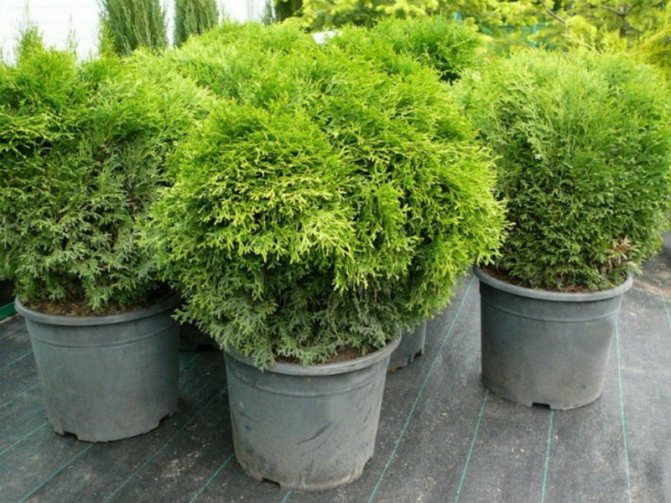

For a full-fledged wintering young thuja, a slight decrease in indicators is enough - no more than +10 degrees. Serious frost is dangerous for her. Remember to have light in the room. It is necessary to control the humidity indicators, in dampness the coniferous culture can rot.
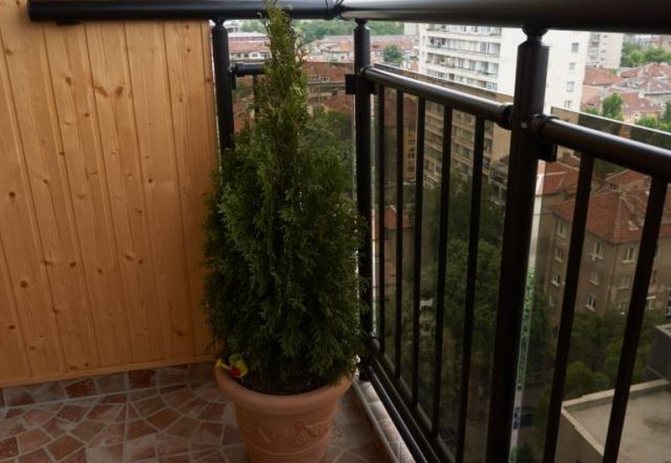

In order for the thuja to grow well during the growing season, it needs a full wintering, which is dangerous for young plants. It is easiest if the crop is planted in a portable pot and can be easily moved into the house. Plants on the site must be covered, because strong winds, snow drifts and frost can destroy them.
Types of the most common mistakes
Inexperienced gardeners who have never encountered the cultivation of a crop immediately make a lot of mistakes. As a result, the tree cannot stand them and over time either dries up or decays. Here are the options for the most common mistakes from agricultural practice:
- for the winter, the crowns of young trees are left uncovered;
- use fertilizers that are intended for deciduous trees (nitrogen complexes);
- do not cover the needles with sun screens;
- take cover too early.
An important step in the development of a tree is crown formation. If it is incorrectly laid, then the plant immediately loses its appearance. Therefore, after the shelter is removed, the thuja must be cut off. For pruning, take a secateurs, they are comfortable to work with. First of all, remove from the top and middle part of the tree dry and diseased branches with yellow needles, they are already dead. If the crown is too thick, discharge it a little. This will increase the breathability of the tree and also reduce the risk of pests attacking the crop. So that your thuja grows better not upward, but in width, cut off part of the top, trimming the top helps to stimulate the lateral shoots, they are activated. There are 3 types of thuja pruning:
- spiral. The most common form for pruning thuja. in general, the tree resembles a large cone, its top will be narrowed;
- spherical. The option is suitable for the formation of low crowns. The plant looks great in the summer cottage, in the winter garden;
- topiary.The crown is formed in the form of any geometric shape: rhombus, square, ball. In garden stores, metal frame forms are sold for laying the crown, according to which they are subsequently pruned.
Read also How to properly store rose hips at home
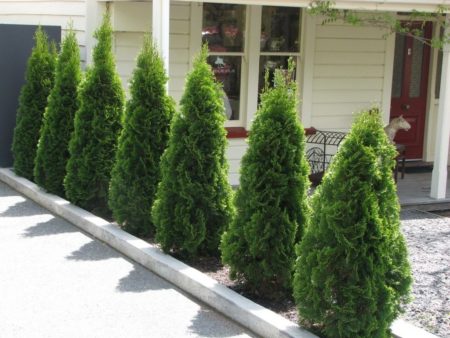

Thuja will be the main decoration of your local area, if you take care of it correctly: cover it from the cold outside, trim the crown, and water it regularly. A healthy and beautiful tree is pleasing to the eye and attracts the attention of everyone around. Thuja can live for tens of years, no matter in which region you planted it, so if you love evergreens, then the choice for planting is obvious.
A lot of grief and disappointment can bring your favorite thuja in the spring, if you do not take care of its preparation for winter in advance. And in this case, careful and timely warming and protection from ultraviolet rays of an evergreen tree becomes an urgent task. What needs to be done in order not to face the risk of burns, adhesion of snow and other unfavorable factors of the cold season, we will tell in our article.
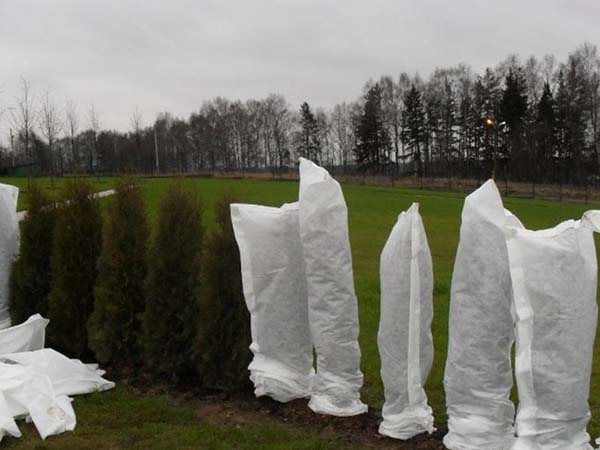

Thuja after winter
With the onset of spring, many gardeners observe an unpleasant picture: the leaves of the thuja have become brown, and the branches are dry. This can be due to a number of reasons.
- High alkali content in the soil. Tui grow in light, slightly acidic soils. It will be possible to identify this reason using a special indicator test (sold in shops for gardeners).
- Sunburn. Probably, the shelter was chosen incorrectly, as the material was transmitting ultraviolet rays. A weakened tree can be damaged by insects or get sick with fungal diseases. Treatment of the crown with fungicides will help restore the plant. However, the treatment process will be long (2-3 years).
- Also, improper planting can cause shrinkage. The tree can be easily "moved" to another location.
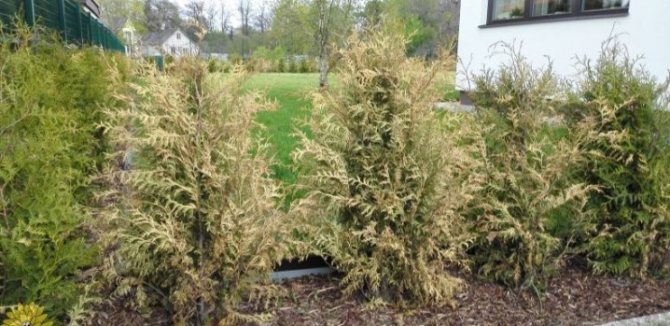

For information on how to care for thuja in winter, see the next video.
A lot of grief and disappointment can bring your favorite thuja in the spring, if you do not take care of its preparation for winter in advance. And in this case, careful and timely warming and protection from ultraviolet rays of an evergreen tree becomes an urgent task. What needs to be done in order not to face the risk of burns, adhesion of snow and other unfavorable factors of the cold season, we will tell in our article.
Do I need to cover thuja for the winter: why do I need to do this
It is worth knowing that thuja is a fairly winter-hardy plant. Therefore, for the winter, thuja need to be covered for several other reasons:
But! Annual thuja, for example, propagated by cuttings, still has a very superficial root system. And if there is a frosty and snowless winter, the plant may die.
- against snow (especially important for young plants);
- to prevent sunburn (for young and adults growing in the sun).
Young thuja (from a year to 4-5 years old) are quite tender, because of which they can deform under the snow cover. When snow sticks to the branches, they bend strongly and can simply break under the weight of the snow masses.
By the way! Moreover, it is necessary to cover multi-barreled thuja from the adhesion of snow.
However, if you have winters very snowy, then adult thuja is better at least tied for the winter.
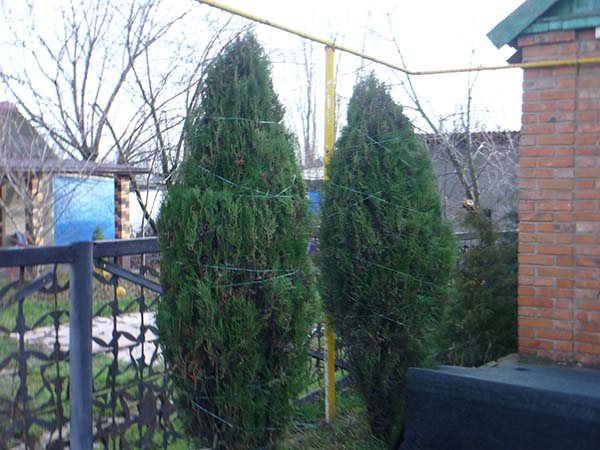

But already adult and / or tall thujas will hardly break under the weight of snow (however, it happens), but they should be covered for another reason - to protect the needles from sunburn in the early spring period (February-April).


Naturally, young plants all the more definitely need to be covered for the winter from the scorching sun.
Important! If the thuja is not exposed to direct sunlight, in other words, it is planted in partial shade, then many believe that it is not necessary to cover it, since it is already protected from the bright spring sun. However, during this period, thuja also suffers from drying out of the needles.
When to cover thuja for the winter
Shelter times vary depending on when snow starts to fall in your area. Thus, for example, in the middle lane (Moscow region), it is possible to shelter thuja for the winter not earlier than the second half of October-November, but in the Urals and Siberia it is recommended to do this, of course, much earlier.
By the way! Many gardeners cover their thuja from sunburn directly in the transitional winter-spring period, that is, in February-March (sometimes even April).
P.S. To do this, you must live in a private house or be able to get to the dacha.
How to properly cover thuja for the winter: protect from snow and sun
Basic rules for sheltering thuja for the winter:
- In no case do not use cellophane or plastic wrap, since it does not allow air to pass through and the plant under it can rot.
- To protect against snow adhesion great fit nonwoven covering materials, which is good let the air through.
- But! Many special nonwoven covering materials, breathablee.g. agrofibre, spunbond, let ultraviolet rays pass along with it! They can hide from the snow, but they cannot protect from the sun, so thuja will definitely get burns under them.
- To protect thuja from the sun can be used roofing paper, gauze, craft paper, white cotton fabric (sheet, duvet cover), polypropylene bags, roofing felt, burlap, polymer mesh.
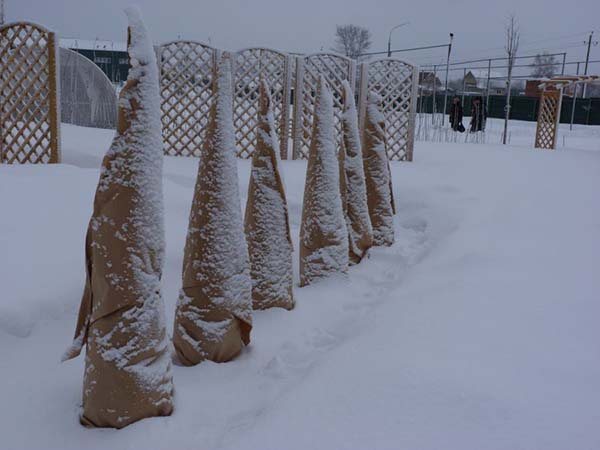

Advice! If for shelter you immediately use materials that do not allow ultraviolet rays to pass through, then you will kill two birds with one stone at once.
Mulching the trunk circle
Before covering the thuja, it is very important to mulch the soil around the trunk circle.
Almost any loose material can be used as mulch: peat, coniferous litter, bark of coniferous trees, compost, humus, sawdust, dry leaves. The thickness of the mulching layer is 5-10 cm.


Mulch will help to retain moisture (reduce its evaporation) and protect the root system of still young conifers, in which it is not yet too well developed and can freeze out if the winter is very frosty and snowless.
Video: warming thuja seedlings for the winter
The evergreen coniferous plant thuja is considered to be quite frost-resistant. But some varieties can freeze slightly in our harsh winters. In addition, there are other troubles from which it is worth protecting the tree.
Thuja requires special care in the first years after planting. Thuja tolerates the cold season quite well. But other factors can harm it: snow, wind, sunburn in winter or early spring. To protect the tree from this, it must be prepared for wintering in the fall.
Read also Do-it-yourself Rope Town
Disinsection and pest control
Fungal infections are the scourge of conifers; they attack the plant both in early spring and in autumn. In order to prevent the mass reproduction of infections, pest control should be carried out no later than a month before the expected shelter of the thuja for the winter, until the average daily air temperature drops below + 12 ° C. For this purpose, copper-containing preparations are suitable, such classic fungicides as:
- "Bordeaux liquid";
- Abiga Peak.
Trees are treated with drugs according to the instructions on the package.
Changing the color of the needles - yellowing, blackening, drying out of individual branches - a signal for a careful examination of the thuja crown. There is a possibility of being hit by a false shield (or coccid). If you do not fight this dangerous pest, it will destroy the plant. The eggs of the larvae of the false shield are carried by the wind, which causes the infection of neighboring plants.
Therefore, when a pest is detected, the processing of nearby areas is also done.
In order to prevent, the crown is sprayed in early spring and in the middle of summer, when new offspring of false shields appear. With a strong infection of the needles, systemic drugs are used to combat the pest, these include:
Insecticides:
- "Confidor";
- Aktara;
- Angio;
- "Antikhrusch".
Organophosphorus:
- Actellik;
- Karbofos.
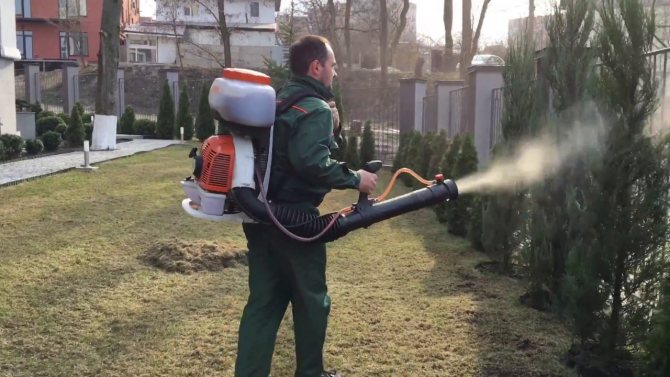

Spraying thuja.
Chemicals are diluted in accordance with the instructions, after which the area of the plant's near-stem circle is watered. Treatment is carried out 2 times per season with an interval of 14 days and alternating chemicals.
Why do they make a thuja shelter for the winter
Most of all, young plants need shelter. They are still rather weak with thin shoots. Adult shrubs, in principle, hibernate without shelter. However, during very frosty and sunny winters, they can also freeze slightly.
If it is covered with snow in winter, this can lead to sputtering of the needles and deformation of the crown. Sheltered for the winter the plant will be protected from all these troubles.
Especially dangerous for shrubs sunburn in springwhen the air warms up quickly. If the crown is not covered, it stimulates the growth of new shoots. But the soil has not thawed yet and the roots of the thuja are dormant. As a result, the following can happen to the plant:
- change in crown color;
- falling off and drying out of needles;
- curvature of shoots.
However, the plant needs protection not only from the spring sun. After all, ultraviolet rays are reflected from the snow and can "burn" thuja needles in winter.
Warming of thuja roots
In addition to the crown of the thuja, it also needs insulation of the roots. Several options are suitable here:
- Leaves mixed with earth. In addition to the insulation itself, they will retain moisture at the roots, and when they rot, they will become fertilizer for the plant.
- Mulching with peat or other organic compound. The main thing is that the mulch layer is loose.
- The roots can also be insulated with sawdust.
Top on a layer of organic matter or sawdust well put spruce branchesthat is harvested in the spring. This is especially important for young seedlings. After all, their roots are still not strong. And such a "blanket" will protect them from severe frosts. It is important to water the plants abundantly before winter so that the earth is moist.
Shelter material
Now there is a fairly large selection of covering materials: agrotherm, agrospan, spunbond, lutrasil. Some gardeners do not recommend using spandob or lutrasil, believing that they are poorly breathable and moisture accumulates under them. Others use these materials with success.
However, gauze is quite applicable as a heater. Only when using it, you should not tighten it too much, because after it gets wet, it will shrink.
Suitable for shelter and kraft paper, burlap... It is advisable to choose a covering material in white, since it reflects the sun's rays well.
How to insulate thuja
In principle, the thuja can be attributed to the most hardy trees. But it becomes so only at the time of maturity, and young plants definitely need shelter for the winter.


The crown of the youngest small trees may well overwinter under plastic bottles. But it is worth growing up - they are replaced by spunbond or ordinary thick paper, with which the crown should not be wrapped too tightly.
To insulate the roots of a tree at any age, the trunk circle is mulched. This is done after abundant autumn watering.
The mulch layer should be 5-20 cm thick - it all depends on the health of the thuja and the expected forecast for the severity of winter. The recommended materials for mulch are pine needles, peat, dry leaves, compost, straw.
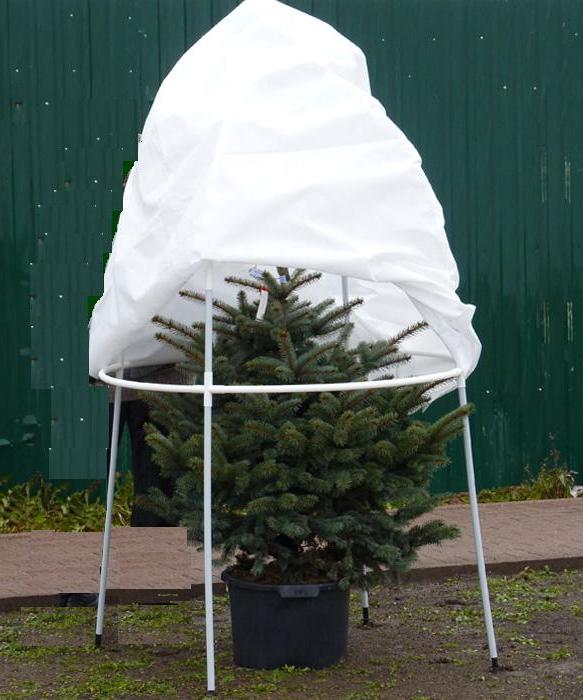

How and when is the best time to cover the thuja
All activities for warming thuja are good to start in autumn before frost and the first snow. But it is important not only to properly cover the plant, but also to carefully release it in the spring. It is best to wait until the ground thaws, and the weather will be consistently warm.
You should be more careful with the spring sun, so that it does not harm the plant. Alternatively, you can install special shieldsthat will shade the thuja.
Shelter options for thuja may be different. Just a bag of covering material of the right size. Tree branches first neatly tie, and then just put it on the thuya. Here you need to make sure that the bag does not tighten its crown.
If there is no bag, just cover material will do. The branches are likewise carefully tied so as not to injure them. Then you can wrap with material and secure it using ropes or wire. Snow from the shelter must be shaken off periodically
Shelter from the sun
Despite the fact that it does not warm, the winter sun can burn trees. The likelihood of such a nuisance increases especially in the second half of February.
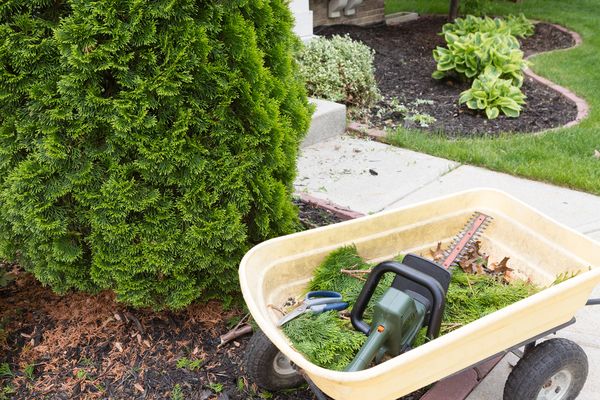

Therefore, to protect the bark of the thuja, by this time it is necessary to place special shields on the sunny side - so that they create a shadow for the trunk.
Summing up the results of the autumn-winter plan for the care of thuja, it is also important to note that from the end of summer it is strictly contraindicated to apply nitrogen-containing fertilizers for it.
The fact is that, in principle, they are growth stimulators for all plants, while at the end of the season, the inhabitants of the garden need rest.
Construction of a frame for sheltering a thuja
This method is hardly suitable for tall trees. But for a medium-sized plant, it is quite acceptable. Such a shelter, if desired, can be done with your own hands. For example, drive several long sticks or twigs around the circumference of the tree.
Above the thuja, they can be tied together. Thereafter the material is pulled onto the base... Beforehand, the branches of the bush must be tied with a rope, but not tightly. A shelter in the form of a hut is good because snow will not accumulate on the surface.
To protect young plants from strong wind, so that it does not damage the crown, you can dig in a pole or stake parallel to the trunk and carefully tie a tree to it. The frame, although a rather labor-intensive construction will reliably protect the plant from the wind of frost and burns.
It is not necessary to make a shelter yourself, you can buy a ready-made structure in a store. Do not throw snow over the top of the shelter, otherwise the needles can resist. For the same reason, it is not advisable to use polyethylene or blankets as a shelter.
With such warming, the plant can first support it, and freeze when severe frosts come. It is not necessary to tighten the plant tightly, it is important that air circulated between branches.
In adult specimens of thuja, only the very top can be sheltered from the sun. If you properly ensure the wintering of thuja, it stay healthy and beautiful... Such a plant will adorn any site.

